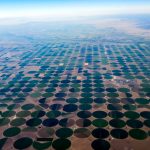Imagine walking through your farm and seeing every plant thriving, lush, and green. It’s a picture of success, isn’t it?
The secret behind such a vibrant farm often lies beneath the surface—literally. An efficient farm irrigation layout can transform your crops’ health and boost your yield. But where do you begin? Designing the perfect irrigation system might seem daunting, but it doesn’t have to be.
You’ll discover the essential steps to create an irrigation layout tailored to your farm’s needs. You’ll learn how to optimize water use, save on costs, and enhance crop growth. Whether you’re a seasoned farmer or just starting out, understanding the nuances of efficient irrigation will empower you to make informed decisions that benefit your entire operation. Stick around, and you’ll find practical advice and insights that could change the way you farm forever.

Assessing Water Needs
Efficient farm irrigation begins with understanding the land’s water needs. Proper layout ensures crops receive optimal hydration. Design focuses on balancing water supply with soil and crop requirements, minimizing waste and maximizing growth.
Assessing water needs is the cornerstone of designing an efficient farm irrigation layout. Every plant has its unique thirst, and understanding this can make or break your farming success. By accurately assessing the water requirements of your crops, you not only optimize growth but also conserve precious resources.Understanding Crop Requirements
Different crops have varied water needs. Think about the demands of thirsty corn versus drought-resistant lavender. You can start by researching specific needs of each crop on your farm. Consider climate, soil type, and growth stage. This ensures you provide just the right amount of water.Evaluating Soil Conditions
Soil acts like a sponge. The capacity to hold water varies significantly between sandy and clay soils. You might have noticed how quickly water drains through sandy soil or how clay tends to retain moisture. Conducting a simple soil test can help you understand its water retention capability. This knowledge is crucial for planning irrigation frequency and duration.Monitoring Weather Patterns
Weather plays a huge role in determining water needs. A sudden downpour can alter your irrigation schedule. Use reliable weather forecasts to plan ahead. During dry spells, you might need more frequent watering. On rainy days, natural precipitation can reduce irrigation requirements.Using Technology For Precision
Modern technology can simplify the process. Consider installing soil moisture sensors. These devices provide real-time data, helping you gauge when your plants need watering. Imagine having a system that alerts you when your crops are thirsty. This not only saves time but also ensures your plants get precisely what they need.Observing Plant Health
Your plants can tell you a lot if you pay attention. Wilting, yellowing leaves, or slow growth might indicate water stress. Regularly inspect your crops for these signs. This personal touch ensures you address issues promptly, optimizing your irrigation strategy.Reflecting On Personal Experiences
Years ago, I underestimated the water needs of my tomato plants during a particularly hot summer. Observing their struggle taught me the importance of factoring in unexpected weather changes. Have you ever had such a revelation? It underscores the value of continuously refining your approach based on real-world experiences. Assessing water needs isn’t just about calculations; it’s about understanding and responding to the dynamic environment of your farm. What steps will you take to ensure your irrigation layout meets your crops’ needs effectively?
Choosing Irrigation Systems
Choosing the right irrigation system is crucial for farm efficiency. An effective system conserves water, reduces labor, and maximizes crop yield. Each farm has different needs, influenced by factors like climate and soil type. Understanding these needs helps in selecting the most suitable system. The choice impacts your farm’s productivity and sustainability.
Understanding Different Irrigation Systems
There are various irrigation systems available for farms. Each system offers unique benefits. Some common systems include drip, sprinkler, and surface irrigation. Drip irrigation delivers water directly to the plant roots. This reduces water wastage and improves plant health. Sprinkler systems mimic natural rainfall, covering larger areas. Surface irrigation involves distributing water over the field’s surface. This method is cost-effective and simple to set up.
Drip Irrigation
Drip irrigation is efficient and water-saving. It uses a network of pipes and emitters. Water drips slowly to the plant roots. This method minimizes evaporation and runoff. It suits farms with water scarcity and diverse crops.
Sprinkler Irrigation
Sprinkler systems distribute water evenly across fields. They are ideal for large areas. The system mimics rain, promoting uniform growth. Sprinklers can be adjusted to control water output. This flexibility helps in managing water distribution.
Surface Irrigation
Surface irrigation is traditional and widely used. Water flows over the land by gravity. This method is suitable for flat and large fields. It is cost-effective and requires minimal technology. Farmers can easily manage the water flow and coverage.
Factors Influencing System Choice
Several factors influence the choice of an irrigation system. Consider the farm’s size and layout first. Soil type affects water absorption and retention. Climate conditions influence water needs. Crop type also determines water requirements. Assessing these factors ensures the best system selection.
Layout Planning Strategies
Designing an efficient farm irrigation layout requires careful planning of water distribution systems. Properly positioned pipes and sprinklers ensure even coverage, minimizing water waste. Consider soil type and crop needs to optimize water usage and boost crop yield.
Designing an efficient farm irrigation layout is crucial for maximizing crop yield and conserving water. Good layout planning ensures that water reaches every part of your farm effectively. It’s not just about placing pipes and sprinklers; it’s about strategic thinking and careful planning.Understanding Your Farm’s Topography
Before you start planning, take a walk around your farm. Notice the slopes, elevations, and any natural water sources. This will help you decide where to place your irrigation lines. A farm with a gentle slope can use gravity to its advantage, reducing the need for energy-consuming pumps. Have you ever noticed how water naturally flows to the lowest point? Use this to your advantage.Choosing The Right Irrigation System
Not all irrigation systems are the same. Consider whether drip, sprinkler, or surface irrigation suits your crops best. Drip irrigation is excellent for water conservation and is ideal for crops like tomatoes and strawberries. Sprinklers are versatile and great for larger areas. Choose a system that matches your crop’s needs and your farm’s size.Designing For Water Efficiency
Think about how you can minimize water waste. Install sensors that can detect soil moisture levels and automate your irrigation schedule. This way, you only water your crops when necessary. Have you ever considered the impact of wind on your sprinklers? Wind can carry water away from your crops, so plan your layout to minimize this.Mapping Your Irrigation Zones
Divide your farm into zones based on water needs and crop types. Some plants need more water than others. By creating zones, you can tailor the water supply to each section, ensuring every crop gets what it needs. This approach also helps in managing water resources more efficiently.Planning For Maintenance
An efficient layout is not just about installation but also about maintenance. Make sure your design allows easy access to pipes and valves for repairs. Consider the long-term ease of maintaining your system. Have you ever struggled to fix a leak because it’s hard to reach? Avoid this by planning for maintenance from the start. Remember, your farm irrigation layout is an investment in your farm’s future. What steps will you take to ensure it’s as efficient as possible?
Maintenance And Optimization
Maintaining and optimizing your farm irrigation layout is crucial for ensuring the longevity and effectiveness of your irrigation system. Regular upkeep not only prevents costly repairs but also enhances water efficiency and crop yield. By focusing on these aspects, you can make sure your irrigation system runs smoothly and supports your farming goals.
Regular Inspection And Cleaning
Inspect your irrigation system frequently to catch any potential issues early. Look for leaks, blockages, or wear and tear on hoses and pipes. Cleaning filters and nozzles regularly prevents clogs and ensures even water distribution.
When I first started farming, neglecting these simple checks led to uneven irrigation and a drop in crop quality. Now, a routine inspection is part of my weekly schedule, saving time and enhancing productivity.
Adjusting Water Pressure
Proper water pressure is essential for efficient irrigation. Too high or too low pressure can lead to uneven watering and wasted resources. Use pressure gauges to monitor and adjust the pressure according to your crop’s needs.
Consider how your plants respond to varying water pressure. Are some areas of your farm too soggy or too dry? Adjusting pressure can balance the water distribution, optimizing growth and health.
Seasonal System Calibration
Each season presents different irrigation challenges. Calibrate your system to match seasonal changes in temperature and rainfall. This ensures your crops receive the right amount of water throughout the year.
During a particularly dry summer, I learned the importance of seasonal calibration. By adjusting the system, I minimized water usage while maintaining crop vitality. This experience taught me the value of adapting to nature’s rhythm.
Implementing Technology
Modern technology offers tools for optimizing irrigation systems. Consider using automated controllers or moisture sensors to streamline your irrigation process. These tools provide real-time data, helping you make informed decisions.
Have you explored the benefits of technology in irrigation? It can simplify your workload and enhance water efficiency, giving you more time to focus on other farm tasks.
Training And Knowledge Sharing
Ensure everyone involved in farm operations understands the importance of irrigation maintenance. Sharing knowledge and training your team can prevent mishaps and promote a culture of care.
When I trained my team on irrigation upkeep, productivity soared. Knowledge sharing not only empowers individuals but also strengthens the overall farming operation. How might you implement this on your farm?
By focusing on maintenance and optimization, you can enhance your farm irrigation system’s efficiency. Regular inspection, pressure adjustment, seasonal calibration, technology implementation, and knowledge sharing are key steps to achieving this. What strategies will you adopt to improve your irrigation layout?
Conclusion
Creating an efficient farm irrigation layout boosts productivity. Saves water. Protects crops. Start with a clear plan. Understand your farm’s needs. Consider the soil and crop types. Use the right equipment. Regular maintenance ensures longevity. Keep an eye on water usage.
Adjust as needed for best results. A well-designed system supports sustainable farming. Benefits are clear. Improved yields. Lower costs. Better water management. Remember, simple steps lead to success. Stay informed. Make smart choices for your farm’s future. Embrace technology. Enhance your irrigation strategy.
A little effort goes a long way in farming.

